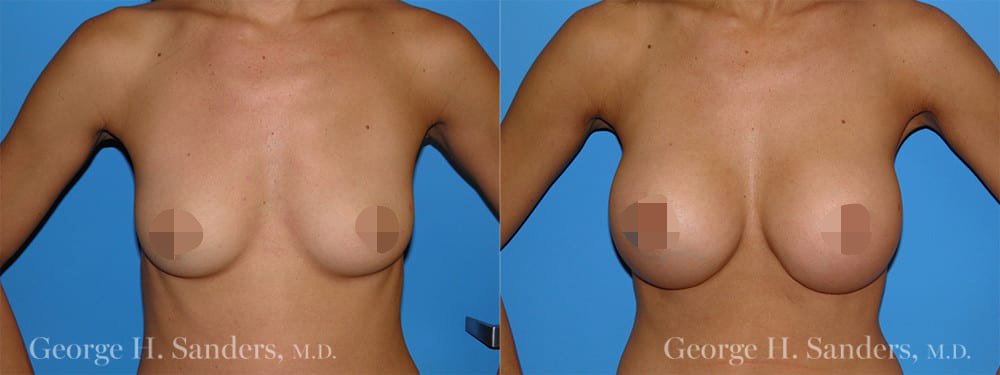If you have recently decided to move forward and schedule a breast augmentation procedure, you might be wondering what the right incision for your breast implants is.
An incredibly common question and concern among women who plan to undergo a breast enhancement surgery, determining which incision is right for you is nearly just as big of a decision as the procedure itself. The incision can affect everything from scarring and recovery to long-term results and even future breastfeeding opportunities.
To help you get a better understanding of each incision, as well as the procedure itself, we have put together a comprehensive guide on choosing the right incision for your breast augmentation surgery.
What is Breast Augmentation?
Firstly, what is breast augmentation? And what are its benefits? Breast augmentation is a plastic surgery procedure that uses breast implants (either silicone, or saline, or a combination of both) to increase a woman’s breast size, fullness, and elevation while artistically shaping the breast into a natural-looking, beautiful contour.
With the ability to help women achieve the breast size, shape, and contour they have always dreamed of, breast augmentation can help a woman feel more self-confident and secure in her own body.
Types of Breast Implants
Deciding on the type of breast implant you will receive is just as important as deciding the location of your breast augmentation incision. Why? Because the type of implant you choose directly influences the location of the incision.
Not to mention, implant type and shape affect the results you will see after surgery, which is why Dr. Sanders encourages you to learn as much as you can about breast implants. Below, he shares a quick overview on implants that should be helpful as you begin your research into the ideal breast augmentation incision for you, implant options, and more.
Silicone Breast Implants
Silicone implants are pre-filled with a silicone solution, which is meant to mimic the texture and feel of natural breasts. Many women prefer silicone implants because they offer a more realistic feel and appearance.
However, it is important to note silicone implants often require a slightly larger incision compared to saline implants and are only available to patients 22 and older.
Saline Breast Implants
Compared to silicone implants, saline implants offer the advantage of a smaller incision, as they are inserted into the breast and filled with a saline solution through a small tube.
Additionally, saline implants are available in several different sizes (width) and projections (the amount the implant pushes the breast forward), which makes it easy for a plastic surgeon to customize the implant to your unique needs and goals.
Before and After Photos

View Our Breast Augmentation Gallery
Breast Augmentation Incision Options
When planning your breast augmentation procedure, there are a number of important decisions to make, including incision location and which is ideal for your unique aesthetic goals.
Currently, there are 4 different breast augmentation incisions surgeons use to insert implants: inframammary incision (under the breast), transaxillary incision (through the armpit), periareolar incision (around the nipple), and trans-umbilical incision (through the belly button).
In the sections below, we will discuss the advantages and disadvantages of each incision, what factors to consider when making your incision decision, how each incision works for implant insertion, and the risks of each incision.
This information will better help you determine which breast augmentation incision is right for your specific anatomy and goals. Let us dive in and look at each incision type individually.
Under the Breast (Inframammary Incision)
The inframammary incision, otherwise known as the breast fold incision, is the most common (and likely the most popular) breast augmentation incision technique used in the United States. In fact, it was the original incision used for breast enhancement procedures and continues to be used as a go-to technique among many plastic surgeons.
Positioned under the breast where the lower part of the breast meets the chest wall, an inframammary incision makes it easy for an experienced plastic surgeon to insert either saline or silicone implants below or above the muscle, as well as find optimal placement for the most natural appearance.
Advantages of the Inframammary Incision:
- When placed correctly, an inframammary incision scar is easily hidden under the volume of the breast, by a bra, or even underneath a bikini.
- Due to the closeness of the area being operated on (i.e. the breast itself), surgeons have more control over bleeding and precision than they do with other incisions, like the transaxillary or umbilical incision.
- It allows for excellent access and vision of the pocket to achieve accurate and optimal placement of the implant.
- The original incision site can be reopened for subsequent surgeries, if necessary. For instance, if a breast implant replacement is needed, a surgeon can reopen the scar under the breast, which means there is no additional scarring.
- The inframammary incision presents no additional risk of nerve damage in the nipples.
- It avoids the milk ducts that are important for nursing, which means breastfeeding may still be an option, and also avoids the bacteria found in these ducts that may contribute to painful and disfiguring scar contracture.
Disadvantages of the Inframammary Incision:
- If the scar migrates upward from the fold after surgery is completed, it may stretch out and be more noticeable.
- This type of incision makes it difficult for a woman to change her breast size later on down the road. For example, if a woman decides to increase her breast size, this might make the scar move up so it is on the breast itself. On the other hand, if she decreases it, the scar can move down so it is visible below the fold of the breast.
- For patients who undergo breast augmentation with very small breasts to begin with or have no natural breast crease, it is sometimes difficult for a plastic surgeon to place the incision in an optimal position. However, this risk can be minimized by going to a highly experienced plastic surgeon.
Around the Nipple (Periareolar Incision)
A periareolar incision, also known as a nipple incision, is made between the areola, which is the darker skin encircling the nipple, and the surrounding skin of the breast. The incision is usually made on the lower half of the areola and from there a breast pocket is created above or underneath the muscle. Once ready, an implant is slid through the incision, moved into the breast pocket, and optimally positioned by the plastic surgeon.
Advantages of the Periareolar Incision:
- The scar often heals well compared to other breast augmentation incisions.
- If the incision is delicately placed at the precise junction of the dark areolar skin and the lighter colored surrounding skin, the scar is barely noticeable. Sometimes, a periareolar incision is camouflaged so well it is nearly invisible.
- The incision point is acutely close to the implant location, which makes it easy for plastic surgeons to control bleeding during surgery and be very precise in their placement of the implants.
Similar to inframammary incisions, a periareolar incision point can be reopened and reused if future surgeries on the breast are needed.
Disadvantages of the Periareolar Incision:
- Of all the breast augmentation incisions, the periareolar incision is associated with the greatest chance of inability to nurse a child after the procedure, although the risk is quite low.
- If the scar does not heal well after breast augmentation, which is always possible, it may be much more visible than you might like (such as raised or lighter in color than your areola). In some cases, this may require corrective surgery.
- There is also a slight increase in the risk of altered nipple sensation compared with the other incisions.
- Some studies have suggested that a periareolar incision poses a higher risk of capsular contracture than do the other incision types.
- The periareolar incision should only be used when the areola has sufficient diameter to allow for insertion of an implant.
- A silicone implant requires an areolar diameter of at least 1½ inch on the skin for the placement of a small implant. Larger implants will require larger diameters to avoid skin injury as well as to avoid implant damage that can result in a predisposition to leakage. This makes the periareolar incision virtually impossible for those desiring larger silicone breast implants.
Under the Armpit (Transaxillary Incision)
The transaxillary incision, which is more commonly known as the under the armpit incision, is an advanced surgical technique that involves creating a careful incision in the armpit’s natural fold. After the incision is made, the plastic surgeon creates a pathway to the breast and a pocket for the breast implants is constructed, where they can either be placed above or below the muscle.
Additionally, the transaxillary incision procedure is most often an endoscopic approach, meaning the incision is remarkably small, typically ranging in length from an inch to an inch and a half. This means the incision can usually be well hidden within the armpit once fully healed.
Advantages of the Transaxillary Incision:
- This incision essentially leaves the breasts untouched, which means it is less likely to damage the mammary glands compared to the periareolar incision. For those who wish to have children and hope to breastfeed, this advantage alone makes it one of the ideal breast augmentation incisions for future mothers.
- Considering there are no incisions on the breast, wearing any kind of bathing suit, undergarments, and low-cut tops without worrying about a visible scar is easily accomplished.
Disadvantages of the Transaxillary Incision:
- It can be difficult to position the breast implant in the popular “dual plane location”, which many plastic surgeons believe is the optimal position for implants in most patients.
- Even though there will be no visible scar on the breast itself, the transaxillary incision can still often leave a scar that may be quite noticeable with sleeveless clothing that shows the armpit, such as bathing wear.
- Surgeons often have less control of the overall position of the breast implant when working through a transaxillary incision. This means it could be difficult when placing the breast implant under the pectoral muscle.
Through the Belly Button (Umbilical Incision)
The trans-umbilical breast augmentation (TUBA) approach is a technique in which an incision is made along the navel (belly button). The surgical tools used will create a tunnel through the abdomen, allowing implants to pass through and be inserted under or over the muscle. Importantly, this approach may only be used to insert a saline-filled implant.
Advantages of the Trans-Umbilical Breast Augmentation (TUBA) Incision:
- Similar to the transaxillary incision, this technique leaves the breasts untouched and is less likely to damage the mammary glands, which makes it ideal for those who plan on having children and hope to breastfeed.
- Nipple sensation is maintained, as the nerves connected to each nipple are not incised.
- The TUBA incision often leaves an undetectable scar, as it is hidden within the wrinkles of your naval.
- The recovery time is typically shorter compared to other breast incision types.
Disadvantages of the Trans-Umbilical Breast Augmentation (TUBA) Incision:
- The TUBA scar, in most cases, cannot be reopened. This means additional incisions are needed if problems arise with the placement of your implants and your doctor has to perform revision surgery, or if you decide to go up in size or have a breast lift later.
- Compared to other breast augmentation incisions, there is a higher risk of implant distortion. With the TUBA incision, surgeons perform quite a distance away from the breasts, giving them less control and precision over pocket creation and implant placement.
- This incision is only an option for saline breast implants. As you can imagine, the belly button gives your surgeon only a small space to work with, which means silicone implants are far too large to be passed through.
- If you choose a breast lift at the time of your breast augmentation, your surgeon will need to make incisions along the breasts, as these procedures cannot be performed through the transumbilical opening. Those who wish to combine procedures will find the ideal breast augmentation incision to be either the inframammary or periareolar incision.
- Furthermore, the trans-umbilical breast augmentation incision is not commonly performed because it requires extensive training, experience, and skill to produce desirable outcomes.
Breast Implant Placement
When determining the right incision for your breast augmentation, it is important to factor in breast implant placement. Implants can be placed over the chest muscle or over the pectoralis major muscle, which is a fan-shaped muscle located over or below the rib cage.
So which placement is right for you and how does this impact your decision in choosing the ideal breast augmentation incision for you?
Over vs. Under the Muscle
Both breast implant placements have several advantages and disadvantages of their own. The over the muscle placement, which is called the “subglandular” placement, is often recommended for bodybuilders or women with overdeveloped pectoral (chest) muscles that can sometimes affect the look of the implant when flexed.
Additionally, placing implants over the muscle offers the advantage of positioning the implants in a more natural location that is not as high on the chest as the submuscular position. Furthermore, some women feel that the over-the-muscle placement is more comfortable and the recovery is slightly easier.
However, many experienced plastic surgeons find there are more established benefits to placing breast implants under the muscle, which is called the “submuscular” placement.
One considerable advantage is that the muscle offers adequate implant coverage, which is important for a more natural appearance, especially in women with very little natural breast tissue. Without enough “padding” around them, implants can look too obvious on the chest and become vulnerable to rippling or cause the skin above the implant to look “wavy.”
Additionally, implants placed under the muscle undergo a little bit of pressure from the muscle, which gives the breast a natural sloped appearance featuring more fullness on the bottom of the implant.
Another important benefit of under the muscle placement is that some radiologists find it is easier to perform and read mammograms compared to the over the muscle placement.
So which implant placement is ideal and how does it impact the crucial decision of choosing the right breast augmentation incision for you? This depends on a couple of factors: the type of implant you want and the size of the implant, as well as your unique anatomy.
For instance, the inframammary incision (under the breast) allows for exceptional access and vision of the pocket. This helps achieve accurate and optimal placement of the implant. If you choose the submuscular placement, which is often a more extensive procedure than subglandular placement, the inframammary incision makes it simple for your experienced plastic surgeon to access the right area and place the implants in the proper position.
Choosing the Right Incision for Your Breast Augmentation Procedure
As you can see, there are many factors to consider when choosing the right incision for your breast augmentation procedure. Fortunately, you do not have to make this decision on your own!
If you are considering breast augmentation, it is best to consult with an experienced plastic surgeon in your area and discuss your options. A distinguished plastic surgeon, such as Dr. George Sanders, will go over all the options available to you and help you understand the advantages and disadvantages of each decision that goes into having a successful breast enhancement procedure.
Have further questions about choosing the ideal breast augmentation incision? Find a specialist in your area or get in touch with our office today.
Dr. George Sanders and his team are proud to serve clients throughout the Los Angeles and San Fernando Valley areas. We are here to answer any questions you may have about breast augmentation or any other aesthetic procedures!







